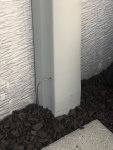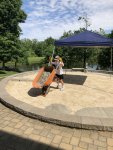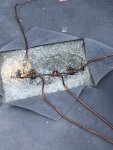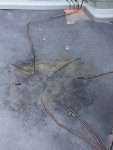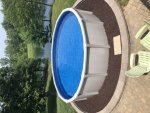Hi all,
Is what we have here safe? My question is about how much of the bonding wire needs to be in contact with the ground, and also why it needs to go all the way around the pool. As the pictures show, the wire is only touching ground where I have dirt piled up. The wire does travel about three feet underground as it goes to the pump (to the left of picture 1).
So the electricians came out today. I was not able to be there and they screwed the bonding wire into the uprights all around the pool. For some reason I was expecting the bonding wire to be 4" below grade and a foot out from the pool, since it a resin pool doesn't need to have point of connection as I understand it. As you may notice, they did leave a length of wire at the end of the loop for me to connect to the water bonding kit that goes on the bottom of the skimmer.
Anyway I had some dirt up against the pool walls since I am going to make a slight slope away from the pool for drainage. However they expected that I would backfill up to the level of the wire. I was going to backfill, but was only planning on a level about height of the bottom rails (and then put landscape fabric on top, then gravel. The wire is several inches higher than the bottom rails.
So to recap, is this safe as is or does the wire need to be in contact with the ground all the way around? I am not sure how high I really want to backfill and slope the ground away, but is there a disadvantage to having them move the wire lower?
Thanks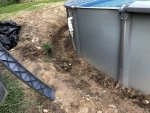
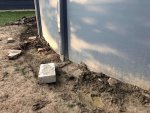
Is what we have here safe? My question is about how much of the bonding wire needs to be in contact with the ground, and also why it needs to go all the way around the pool. As the pictures show, the wire is only touching ground where I have dirt piled up. The wire does travel about three feet underground as it goes to the pump (to the left of picture 1).
So the electricians came out today. I was not able to be there and they screwed the bonding wire into the uprights all around the pool. For some reason I was expecting the bonding wire to be 4" below grade and a foot out from the pool, since it a resin pool doesn't need to have point of connection as I understand it. As you may notice, they did leave a length of wire at the end of the loop for me to connect to the water bonding kit that goes on the bottom of the skimmer.
Anyway I had some dirt up against the pool walls since I am going to make a slight slope away from the pool for drainage. However they expected that I would backfill up to the level of the wire. I was going to backfill, but was only planning on a level about height of the bottom rails (and then put landscape fabric on top, then gravel. The wire is several inches higher than the bottom rails.
So to recap, is this safe as is or does the wire need to be in contact with the ground all the way around? I am not sure how high I really want to backfill and slope the ground away, but is there a disadvantage to having them move the wire lower?
Thanks


Last edited:


